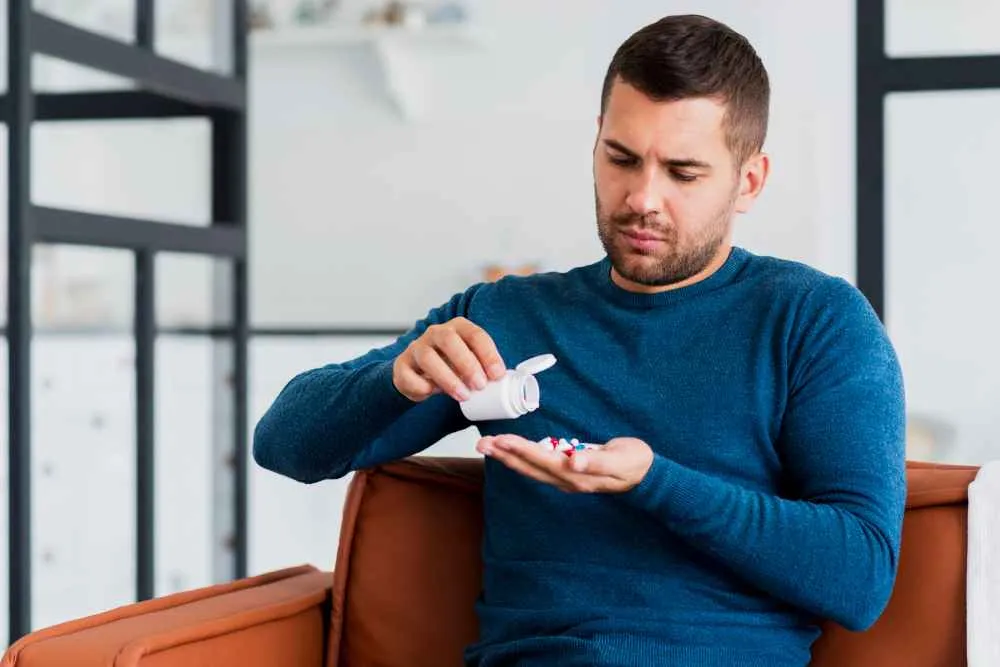Muscle relaxers are prescribed to relieve muscle pain, stiffness, and spasms which are effective for short-term relief. If you are thinking about taking it for a longer period, you might wonder, "Are muscle relaxers addictive?" The answer relies on the type of muscle relaxer. Let's explore the blog and learn about the signs of addiction, risks, and safe use of these medicines.
What are Muscle Relaxers?
Muscle relaxers are commonly prescribed medicines to help relieve muscle pain, stiffness, and spasms caused by back pain or neurological issues. These medications actually work by impacting the way nerves pass the message to the muscles, preventing muscle pain and tension.
Types of Muscle Relaxers
The following are the two main categories of muscle relaxers:
- Antispasmodic Muscle Relaxers: Include carisoprodol (Soma), methocarbamol (Robaxin), and cyclobenzaprine (Flexeril). They reduce muscle tightness and spasms caused by muscle strain and low back pain.
- Antispastic Muscle Relaxers: Include diazepam (Valium), baclofen, and tizanidine. They treat spasticity (increased muscle tightness and tone) caused by conditions such as stroke, cerebral palsy, and multiple sclerosis.
Are Muscle Relaxers Addictive? The Truth
Are muscle relaxants habit-forming? Not all muscle relaxers are addictive or habit-forming. But diazepam (Valium) and carisoprodol (Soma) are the commonly prescribed muscle relaxers that have a high potential for habit-forming. These medicines affect your brain by producing feelings of euphoria and relaxation, contributing to psychological dependence if you misuse them.
So, avoid these muscle relaxers if you have a family or personal history of substance use disorder (addiction). Also, if you are dependent on them or the prescribed dose is not working to manage the symptoms, do not use more than the recommended dose. Seek medical help immediately.
Warning Signs of Muscle Relaxer Addiction
Recognizing the signs can help with early medical intervention. People dealing with muscle relaxer addiction can develop various physical and behavioral signs, including:
- Using large doses: Use of larger quantities or for a longer period than initially intended.
- Unable to avoid them: Unable to reduce or avoid the use of muscle relaxers, even though you wanted to do so.
- Spending more time on drug use: Spending excessive time on getting, using, or recovering from muscle relaxers.
- Developing strong cravings: Experiencing a strong craving or desire to regularly use these medicines.
- Neglecting responsibilities: Ignoring and delaying your responsibilities at home, school, and work.
- Neglecting social relationships and activities: Slow withdrawal from social relationships or activities, with continuous and more focus on obtaining and using them.
- Using the drug compulsively: Using these drugs uncontrollably and repeatedly, despite their adverse physical or psychological effects.
- Developing increased tolerance: This results in wanting higher doses of muscle relaxers with time to achieve the same effects.
- Experiencing withdrawal symptoms: Developing withdrawal symptoms from muscle relaxers, such as anxiety, sweating, restlessness, and insomnia, which occur while reducing or discontinuing the dose of muscle relaxers.
Mechanism of Muscle Relaxer Addiction
This is how muscle relaxers lead to addiction:
- Central Nervous System Depression: Slows down the activity of the brain, which produces euphoria (feelings of great joy or happiness) and relaxation.
- High Dopamine Release: Triggers the release of dopamine, giving a sense of pleasure and dependence.
- Tolerance Development: The body adapts to the medicine over time, which leads to needing higher doses to get the desired effect.
- Physical Dependence: The body and brain become dependent on muscle relaxers, which causes withdrawal symptoms if the dose is discontinued.
- Psychological Dependence: Craving for the medicine for its euphoric or calming effects that make it difficult to quit.
- Reinforcement Cycle: Force to use continuously to avoid withdrawal symptoms, developing a cycle of addiction and dependency.
Risk Factors for Addiction to Muscle Relaxers
These factors can lead to a high risk of addiction:
- Prolonged Use: Muscle relaxers are designed for short-term use (about 2 to 3 weeks). Long-term use can lead to dependence risk.
- High Dosage: The higher the dosage than the prescribed one, the greater the chances of developing tolerance and addiction.
- History of Substance Abuse: People with a past addiction to drugs or alcohol are highly prone to developing addiction.
- Combining with Other Substances: Mixing muscle relaxers with opioids or alcohol can increase their effects, which can lead to a high addiction risk.
- Psychological Dependence: Using these medicines as a coping approach to manage stress, insomnia, or anxiety can also contribute to addiction.
- Lack of Medical Guidance: Taking the medicine without a doctor's supervision raises misuse risk which leads to addiction.
- Mental and Genetic Health Factors: Mental health conditions like anxiety or depression, and a family history of addiction, can make you prone to addiction.
So, to lower the addiction risk, use the prescribed dose of muscle relaxers and find alternative solutions if possible.
How Common is Muscle Relaxer Addiction In the USA?
Addiction to muscle relaxers is a common growing concern in the United States. According to a study, Carisoprodol (Soma) is the most abused drug. The Department of Justice states that about 2,276,000 residents in the USA aged 12 and over have nonmedically used Soma once in their lifetime. Most people are not aware of the complications associated with misusing these drugs. Addiction can lead to severe physical, social, and psychological risks, including death.
Side Effects of Abusing Muscle Relaxers
Understanding the risks of muscle relaxers can help keep you safe.
Physical Side Effects
- Drowsiness
- Fatigue
- Dry Mouth
- Headache
- Impaired Coordination
- Nausea
- Seizures
- Liver Damage
Mental Side Effects
- Drowsiness and Confusion
- Difficulty retaining information and forgetfulness.
- Mood swings
- Hallucinations and delusions
- Impaired judgment
- Dependence and cravings
Note: Report these side effects to your doctor immediately.
Is It Possible to Overdose on Muscle Relaxers?
Yes, taking an excessive amount of muscle relaxers can lead to overdose risk, which can vary depending on many factors. Those factors include age, health, and whether the medicine is mixed with alcohol or other drugs at the same time. Watch for signs of overdose to stay safe and get medical help if necessary.
The following are the common symptoms of overdose:
- Drowsiness or dizziness
- Difficulty breathing
- Confusion
- Impaired coordination
- Slurred speech
- Seizures
- Respiratory depression, coma, and death (if mixed with alcohol)
Important Note: Report these symptoms to 911 (an emergency number for severe symptoms) or 1-800-222-1222 (a Poison Center for overdosing emergencies).
Safe Use of Muscle Relaxers
To avoid the addiction risk and related complications, it is important to:
- Follow Prescription Guidelines: Use the dose only as prescribed by the healthcare providers.
- Limit Usage Duration: Muscle relaxers are only meant for the shortest duration, which is about 2-3 weeks.
- Avoid Alcohol & Other Sedatives: Mixing these medicines with alcohol and other sedatives can raise the risk of overdose, as all these substances cause depressant effects.
- Reduce the Dose Slowly: If discontinuing the medicine, reduce the dose under a doctor's supervision to prevent the risk of withdrawal symptoms.
- Avoid Drive or Heavy Machinery: As these drugs cause impaired coordination and drowsiness, avoid driving or operating heavy machinery to prevent accident risks.
- Watch for Side Effects: Monitor the effects like dizziness, fatigue, confusion, or dry mouth, and report them to a provider.
- Consider Alternative Treatments: Prefer physical therapy, heat therapy, stretching, and over-the-counter pain medications to relieve pain without any risks.
When To See a Doctor?
When taking muscle relaxers, regular visits to a doctor are crucial to monitor how effectively the medicine is working. However, also speak to the providers in these situations:
- developed troublesome side effects
- Symptoms are not improving or becoming worse
- experiencing dependency
Treatment for Muscle Relaxer Addiction
Treatment involves the combination of different approaches that include:
- Medical Detox: The first step involves slow tapering (reducing the dose) of the medicine under a doctor's supervision to safely manage withdrawal symptoms.
- Medication-Assisted Treatment: In some cases, the providers may prescribe medications to alleviate cravings and withdrawal symptoms.
- Cognitive Behavioral Therapy: Helps find out triggers and teaches healthier coping strategies for addiction.
- Support Groups: Offer peer support and encouragement in recovery that motivates them to quit the drugs.
- Family Therapy: Identifies family relationships that may trigger addiction, improves communication, and builds a supportive space to heal properly.
- Holistic Approaches: Yoga, mindfulness practices, and exercises to prevent stress and promote overall health that ease recovery.
- Aftercare & Relapse Prevention: Continued therapy, follow-up care, and support group participation to prevent relapse and promote prolonged healing.
Final Thoughts
So, are muscle relaxers addictive? Though not all, Soma and Valium are the most addictive. So, to avoid addiction risk, always use the medicine as prescribed and for a short duration. Always keep a watch over the symptoms of addiction and report them immediately to a doctor to avoid complications. The doctors can help with treatments like medicines, cognitive behavioral therapy, support groups, and lifestyle changes, which can provide relief from addiction.
Frequently Asked Questions
What is the safest muscle relaxer?
Metaxalone (Skelaxin) is considered the best muscle relaxer as it has lower side effects and sedative effects than other muscle relaxants. However, seek medical guidance to determine the best option for your specific issue
Is it bad to take a muscle relaxer every day?
Yes, daily use can lead to side effects and the risk of addiction.
What muscle relaxer is not addictive?
Methocarbamol (Robaxin) and cyclobenzaprine (Flexeril have a lower addiction risk compared to carisoprodol (Soma). But always discuss the right option with your doctor.
How many days in a row can you take muscle relaxers?
As muscle relaxers are short-term treatments, they should not be taken for more than 2 to 3 days.
Do muscle relaxers make you sleepy?
Yes, they do because they effectively work as central nervous system depressants and cause sedative effects, which relieve muscle pain and spasms, leading to restful sleep.
Reviewed by







